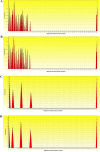Molecular detection and genetic diversity of Leucocytozoon sabrazesi in chickens in Thailand
- PMID: 34404893
- PMCID: PMC8370975
- DOI: 10.1038/s41598-021-96241-7
Molecular detection and genetic diversity of Leucocytozoon sabrazesi in chickens in Thailand
Erratum in
-
Author Correction: Molecular detection and genetic diversity of Leucocytozoon sabrazesi in chickens in Thailand.Sci Rep. 2024 Feb 9;14(1):3373. doi: 10.1038/s41598-024-53903-6. Sci Rep. 2024. PMID: 38336878 Free PMC article. No abstract available.
Abstract
Leucocytozoon sabrazesi is the intracellular protozoa of leucocytozoonosis, which is transmitted by the insect vectors and affects chickens in most subtropical and tropical regions of the globe, except South America, and causing enormous economic losses due to decreasing meat yield and egg production. In this study, L. sabrazesi gametocytes have been observed in the blood smears, and molecular methods have been used to analyse the occurrence and genetic diversity of L. sabrazesi in blood samples from 313 chickens raised in northern, western and southern parts of Thailand. The nested polymerase chain reaction (nested PCR) assay based on the cytb gene revealed that 80.51% (252/313) chickens were positive of L. sabrazesi. The phylogenetic analysis indicated that L. sabrazesi cytb gene is conserved in Thailand, showed 2 clades and 2 subclades with similarity ranged from 89.5 to 100%. The diversity analysis showed 13 and 18 haplotypes of the sequences from Thailand and from other countries, respectively. The entropy analyses of nucleic acid sequences showed 26 high entropy peaks with values ranging from 0.24493 to 1.21056, while those of amino acid sequences exhibited 5 high entropy peaks with values ranging from 0.39267 to 0.97012. The results; therefore, indicate a high molecular occurrence of L. sabrazesi in chicken blood samples with the associated factors that is statistically significant (p < 0.05). Hence, our results could be used to improve the immunodiagnostic methods and to find appropriate preventive control strategies or vaccination programs against leucocytozoonosis in order to mitigate or eliminate the harmful impact of this infection on chicken industry.
© 2021. The Author(s).
Conflict of interest statement
The authors declare no competing interests.
Figures





Similar articles
-
Molecular genetic diversity and bioinformatic analysis of Leucocytozoon sabrazesi based on the mitochondrial genes cytb, coxI and coxIII and co-infection of Plasmodium spp.Parasite. 2022;29:22. doi: 10.1051/parasite/2022022. Epub 2022 Apr 27. Parasite. 2022. PMID: 35475784 Free PMC article.
-
Monitoring the Prevalence of Leucocytozoon sabrazesi in Southern China and Testing Tricyclic Compounds against Gametocytes.PLoS One. 2016 Aug 29;11(8):e0161869. doi: 10.1371/journal.pone.0161869. eCollection 2016. PLoS One. 2016. PMID: 27571513 Free PMC article.
-
Prevalence, morphological and molecular characterization of Leucocytozoon macleani (Apicomplexa: Haemosporida) from chickens in Thailand.Parasite. 2025;32:50. doi: 10.1051/parasite/2025043. Epub 2025 Aug 5. Parasite. 2025. PMID: 40763271 Free PMC article.
-
Multi-strain infections and 'relapse' of Leucocytozoon sabrazesi gametocytes in domestic chickens in southern China.PLoS One. 2014 Apr 11;9(4):e94877. doi: 10.1371/journal.pone.0094877. eCollection 2014. PLoS One. 2014. PMID: 24728499 Free PMC article.
-
Avian haemosporidian parasites affecting non-descript village chickens in Africa.Trop Anim Health Prod. 2025 Jan 20;57(2):28. doi: 10.1007/s11250-024-04250-1. Trop Anim Health Prod. 2025. PMID: 39832046 Free PMC article. Review.
Cited by
-
Diversity and prevalence of Leucocytozoon in black flies (Diptera: Simuliidae) of Thailand.Parasit Vectors. 2024 Nov 19;17(1):475. doi: 10.1186/s13071-024-06567-0. Parasit Vectors. 2024. PMID: 39563389 Free PMC article.
-
Leucocytozoon caulleryi discovery utilizing indirect-ELISA in East Java, Indonesia as a new approach in detecting leucocytozoonosis.Open Vet J. 2025 Apr;15(4):1557-1564. doi: 10.5455/OVJ.2025.v15.i4.6. Epub 2025 Apr 30. Open Vet J. 2025. PMID: 40453850 Free PMC article.
-
Molecular Identification of Host Blood Meals and Detection of Blood Parasites in Culicoides Latreille (Diptera: Ceratopogonidae) Collected from Phatthalung Province, Southern Thailand.Insects. 2022 Oct 8;13(10):912. doi: 10.3390/insects13100912. Insects. 2022. PMID: 36292860 Free PMC article.
-
Prevalence and Diversity of Blood Parasites (Plasmodium, Leucocytozoon and Trypanosoma) in Backyard Chickens (Gallus gallus domesticus) Raised in Southern Thailand.Animals (Basel). 2023 Sep 3;13(17):2798. doi: 10.3390/ani13172798. Animals (Basel). 2023. PMID: 37685062 Free PMC article.
-
A filarial parasite potentially associated with the health burden on domestic chickens in Japan.Sci Rep. 2024 Mar 15;14(1):6316. doi: 10.1038/s41598-024-55284-2. Sci Rep. 2024. PMID: 38491072 Free PMC article.
References
-
- Valkiunas G. Avian Malaria Parasites and Other Haemosporidia. CRC Press; 2005.
-
- Forrester DJ, Greiner EC. Leucocytozoonosis. In: Atkinson CT, Thomas NJ, Hunter DB, editors. Parasitic Diseases of Wild Birds. Wiley-Blackwell; 2008. pp. 54–107.
Publication types
MeSH terms
LinkOut - more resources
Full Text Sources

